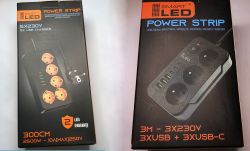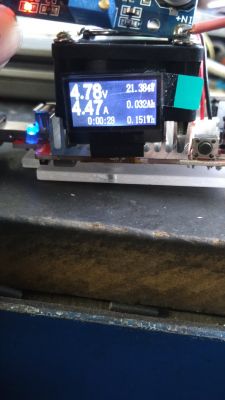Hello.
Below I present a description of the step-down converter based on the XL4005E1 chip.
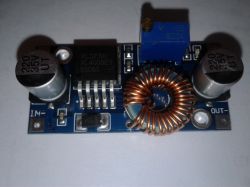
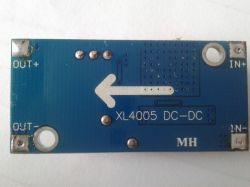
The prices of the converter start on Aliexpress from less than $ 0.95 with shipping, prices with shipping on Polish auction portals start from about PLN 12.
The maximum input voltage for the converter is 32V DC.
The output voltage is regulated with a multi-turn potentiometer in the range from about 0.8 to 30 V, current efficiency up to about 5 A. Operating frequency 300kHz, drop out about 0.6V, built-in thermal, short-circuit and overload protection.
Converter dimensions: 43 x 21 x 14 mm
The converter was tested with an artificial load for input voltages of 12 and 24 V and for output voltages of 5 V. During the tests, the voltages and currents on the input and output sides of the converter were measured, and the power and efficiency were calculated.
Below I present the measurement results.
Input voltage 12V, output voltage 5V:
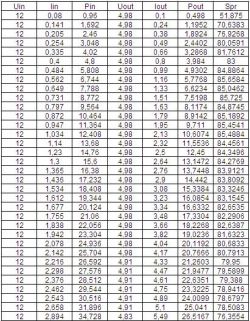
Input voltage 24V, output voltage 5V:
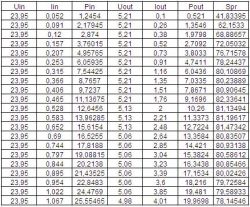
Fitness graph:
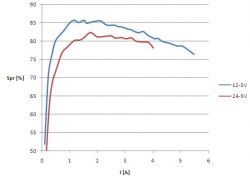
It can be seen that the efficiency of the converter depends on its supply voltage, in this case the lower the supply voltage, the higher the converter efficiency.
When performing the above measurements on an artificial load, during the load change, I turned the load control encoder too much, which resulted in the load of the converter with a current of over 7A for a few seconds, which caused its damage. It was not accompanied by any special effects, just the blue LED on the converter board went out. In the idle state, the maximum output voltage after damage is about 1.5V, but after applying a load, the voltage at the output disappears. The XL4005 chip and the Schottky diode were damaged.
As there were supposed to be more measurements, I decided to buy another converter and repeat the unfinished measurement with 24V input voltage and 5V output voltage, and also make measurements for other voltages. The second inverter was purchased from another vendor.
Here are the results of the repeated measurement for the new converter - 24V / 5V:
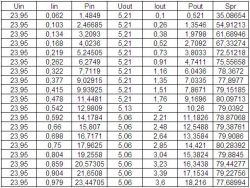
Measurements could not be completed. As you can see, with a load of 3.6A, after a dozen or so seconds it sizzled, hissed and there was smoke with an unpleasant smell of burning electronics.
The effect of this can be seen in this photo:
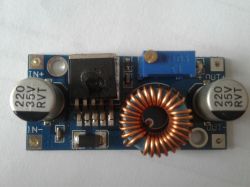
There was a hole in the XL4005 chip, and the Schottky diode was damaged as in the previous converter as a result of too much load.
Both converters were tested with exactly the same equipment and with the same voltages, but between the two copies you can notice a difference in efficiency, although at first glance they look identical.
Below is a comparison of the efficiency of these converters for 24 / 5VDC voltages:

Series 1 - the first converter damaged by excessive load, series 2 - the second converter where a hole was created in the circuit at 3.5A.
Despite the built-in security features, neither of them had worked.
The temperature did not exceed 40 ° C during these tests.
I damaged the first inverter myself by loading it too much, which showed that the overload protection did not work, the second one damaged by itself at a load of about 70% where the temperature of the system did not exceed 40 ° C.
I don't know if I came across a flawed copy or if it was some inept fakes.
Maybe someone who has such a converter will write his experience of using it.
Below are links to the descriptions of two other DC-DC step-down converters on the LM2596 chip, where one has a built-in voltmeter to measure the input and output voltage.
https://www.elektroda.pl/rtvforum/topic3420289.html#16966161
https://www.elektroda.pl/rtvforum/topic3420290.html#16964656
Below is the efficiency diagram for the input voltage of 24VDC, output voltage of 5VDC for the converter based on the LM2596 system, the converter based on the LM2596 system + built-in measurement of the input and output voltage and two converters based on the XL4005 system tested in this article:
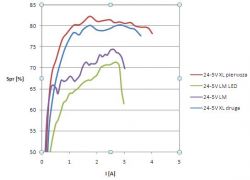
It can be easily seen that the converters based on the XL4005 achieve the best efficiency.
Below I present a description of the step-down converter based on the XL4005E1 chip.


The prices of the converter start on Aliexpress from less than $ 0.95 with shipping, prices with shipping on Polish auction portals start from about PLN 12.
The maximum input voltage for the converter is 32V DC.
The output voltage is regulated with a multi-turn potentiometer in the range from about 0.8 to 30 V, current efficiency up to about 5 A. Operating frequency 300kHz, drop out about 0.6V, built-in thermal, short-circuit and overload protection.
Converter dimensions: 43 x 21 x 14 mm
The converter was tested with an artificial load for input voltages of 12 and 24 V and for output voltages of 5 V. During the tests, the voltages and currents on the input and output sides of the converter were measured, and the power and efficiency were calculated.
Below I present the measurement results.
Input voltage 12V, output voltage 5V:

Input voltage 24V, output voltage 5V:

Fitness graph:

It can be seen that the efficiency of the converter depends on its supply voltage, in this case the lower the supply voltage, the higher the converter efficiency.
When performing the above measurements on an artificial load, during the load change, I turned the load control encoder too much, which resulted in the load of the converter with a current of over 7A for a few seconds, which caused its damage. It was not accompanied by any special effects, just the blue LED on the converter board went out. In the idle state, the maximum output voltage after damage is about 1.5V, but after applying a load, the voltage at the output disappears. The XL4005 chip and the Schottky diode were damaged.
As there were supposed to be more measurements, I decided to buy another converter and repeat the unfinished measurement with 24V input voltage and 5V output voltage, and also make measurements for other voltages. The second inverter was purchased from another vendor.
Here are the results of the repeated measurement for the new converter - 24V / 5V:

Measurements could not be completed. As you can see, with a load of 3.6A, after a dozen or so seconds it sizzled, hissed and there was smoke with an unpleasant smell of burning electronics.
The effect of this can be seen in this photo:

There was a hole in the XL4005 chip, and the Schottky diode was damaged as in the previous converter as a result of too much load.
Both converters were tested with exactly the same equipment and with the same voltages, but between the two copies you can notice a difference in efficiency, although at first glance they look identical.
Below is a comparison of the efficiency of these converters for 24 / 5VDC voltages:

Series 1 - the first converter damaged by excessive load, series 2 - the second converter where a hole was created in the circuit at 3.5A.
Despite the built-in security features, neither of them had worked.
The temperature did not exceed 40 ° C during these tests.
I damaged the first inverter myself by loading it too much, which showed that the overload protection did not work, the second one damaged by itself at a load of about 70% where the temperature of the system did not exceed 40 ° C.
I don't know if I came across a flawed copy or if it was some inept fakes.
Maybe someone who has such a converter will write his experience of using it.
Below are links to the descriptions of two other DC-DC step-down converters on the LM2596 chip, where one has a built-in voltmeter to measure the input and output voltage.
https://www.elektroda.pl/rtvforum/topic3420289.html#16966161
https://www.elektroda.pl/rtvforum/topic3420290.html#16964656
Below is the efficiency diagram for the input voltage of 24VDC, output voltage of 5VDC for the converter based on the LM2596 system, the converter based on the LM2596 system + built-in measurement of the input and output voltage and two converters based on the XL4005 system tested in this article:

It can be easily seen that the converters based on the XL4005 achieve the best efficiency.
Cool? Ranking DIY



